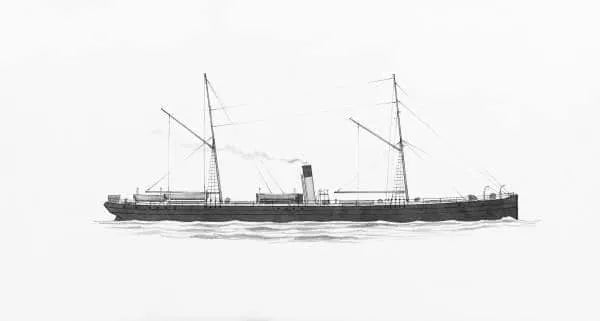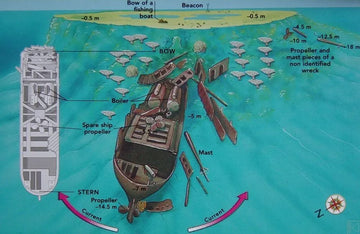The Kingston was a cargo ship built in 1871 by the Commercial Steamship Company in England. With a heavy iron hull of nearly 1,500 tons and 80 meters in length, it was powered by a two-cylinder steam engine, typical of the transition from sail to steamship. This ship was built primarily for cargo transport but also included compartments to accommodate passengers, something not very common for the time.
Diving into this wreck, one of the oldest in the Red Sea, is diving into naval history. This wreck is a link to the early days of steamships and the heyday of the British Empire. Throughout the 19th century, the traffic of ships from Britain to India intensified every day, and ships increasingly used the Red Sea, especially when steamships became larger, with more cargo capacity, and could navigate through treacherous reefs, ignoring the winds and difficult currents of this sea. The volume of steamship traffic crossing the Red Sea increased year by year and grew even faster when the Suez Canal opened in late 1869.

Early steamships were not very fuel-efficient and had to carry additional coal at regular intervals to complete their journey, so ports with coal stocks began to emerge worldwide. Aden, in southern Yemen, is located almost halfway on the route from Suez to India and was a natural choice for a coal station. The only problem was the lack of coal in the area, so they had to bring coal from other places, mainly from Wales, which had high-quality coal, and store it in Aden.
______________________
The best liveaboard offers in the Red Sea
______________________
The Kingston loaded 70 tons of coal destined for Aden in 1881 to supply those steamships that needed it so much. After successfully navigating the North Atlantic and the Mediterranean, it crossed the Suez Canal without problems until it encountered, in calm seas and theoretically perfect for navigation, the north face of Shag Rock. The Kingston, traveling at the maximum speed its engines could give, began to take on water immediately. The crew was able to keep the ship afloat for several days before the stern began to sink, and ultimately, it sank.
Diving in the Kingston
Today it lies in the same position where it succumbed over 130 years ago, with the stern at a maximum of 14 meters and its boilers a few meters below the surface. The bow has disappeared after so many years under the sea, and its remains have spread along the top of the reef, but the stern is in good condition. The shallow depth also allows for a long bottom time, and you are sure to easily exceed an hour of immersion.
In this area, the predominant current comes from the north and splits to sweep around both sides of Shag Rock. The Kingston is just a little west of where the current divides, allowing us to dive with tranquility. Its rudder and propeller are intact and are the first things to visit on this wreck. Then we continue diving along the outside of the stern and along the starboard side of the ship to go up a few meters and penetrate the hull. All the wooden deck has disappeared, leaving only the iron frame.
After more than a century underwater, the profusion of soft and hard corals is extraordinary, the remains are completely loaded with coral in what more than a human creation looks like a natural reef that has been there for thousands of years. In the remains of the Kingston, there are all kinds of colorful fish such as butterflyfish, anthias, damselfish, triggerfish, parrotfish, emperor angelfish, Red Sea banners... opportunities for macro photography are excellent.
Diving in the Kingston
After the boilers, we can appreciate an interesting spare propeller that still remains in good condition and different accessories and machinery, as well as mooring gear. On the starboard side, we can find its two masts. The remains of the Kingston are not very large and can be seen with tranquility, appreciating the quality of the coral that has taken over the remains, and when you finish, you'll have a very interesting surprise. Diving with the reef to our left, we will start to experience a gentle current that gradually becomes stronger, providing some adrenaline to this dive and allowing us to enjoy the coral landscape that Shag Rock forms. Also, with a bit of luck, we can see dolphins and turtles approaching.
```




















